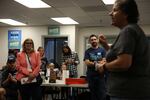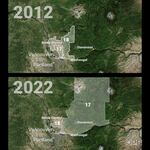In early October, Washington State Democratic Party Chairwoman Tina Podlodowski made a visit to a Vancouver field office, en route to canvass and door-knock for local candidates.
She and candidates spoke in the party office, a basement suite in a downtown office building. There, Podlodowski railed against Republican policies and noted her organization was starting to sprinkle cash and staff resources onto Clark County races.
“This is our moment, I believe, in this area to be able to win and have a Democratic sweep in all of these different races,” Podlodowski said. “This is really our time and our moment to make this happen.”

Washington Democratic Party chair Tina Podlodowski, right, talks to a crowd in October as Democratic candidates Sen. Sharon Wylie, left, and John Zingale look on. Podlodowski said she is optimistic about flipping Republican seats in Southwest Washington thanks to redistricting and the fervor of the Congressional race.
Troy Brynelson / OPB
Two days prior, the party gifted $50,000 to two House candidates. And the party promised to knock on 20,000 doors for some of the candidates in Clark County as reinforcement to drive up Democratic turnout.
Like Washington’s 3rd Congressional seat, a cadre of state-level races have Democrats hopeful they can capitalize on Republican party divisions.
Candidates in the two parties disagree about what they consider to be voters’ biggest issues. Democrats center their campaigns on reproductive rights, health care and combating conspiracies around the 2020 election and COVID-19. Republicans believe inflation and crime are top-of-mind.
In the region’s suburban 17th and 18th state Legislative Districts, where eight candidates are vying for four seats, both parties view the races as more competitive than ever. Only one of the seats has an incumbent, Republican Rep. Paul Harris, and both districts saw significant changes during the 2020 redistricting process.
Republican stronghold
Republicans say the Democrats are fooling themselves if they think they can steal away seats.
“The Democrats are welcome to waste Seattle’s money, but that’s not going to change the results in the 17th or the 18th,” Washington GOP Chairman Caleb Heimlich said.
Heimlich added that Democrats had spent more in the two districts in 2018. The state GOP, meanwhile, he spent at least $40,000 in the districts in October to oppose Democratic candidates.
The two districts had for years been a melding of rural and suburban voters. Both reliably voted Republican.
The last Democrat to win the 17th — which encompassed east Vancouver and central Clark County voters — was Monica Stonier in 2013, who lost re-election after one term. Stonier now represents the 49th District.
Republicans have controlled the 18th even longer. Before redistricting, it was anchored by rural conservatives in northern Clark County while skirting over towns like Ridgefield, Battle Ground, Camas and Washougal. A Democrat never won that district as it was drawn.
In fact, a Democrat hasn’t won a House seat in the 18th in 27 years, or a Senate seat in 37 years.
However, the new districts hardly resemble those of the past decade. The 17th now spans east Vancouver and Skamania County, a teeter-totter of western, suburban voters and eastern, rural voters.

A graphic shows how Washington's 17th and 18th Legislative Districts have been redrawn after the state's redistricting process. Candidates in these races say the new districts make it harder to predict how they will fare in the election.
MacGregor Campbell / OPB
Kevin Waters, a Republican seeking the House seat, said he believes he can win with rural conservatives and affluent suburban Republicans. But it’s difficult to predict, he said, because about 70% of the voters are completely new to the district.
“It’s just a huge unknown,” said Waters, an economic development official from Stevenson.
Some believe the predominance of Mitt Romney-mold Republicans in east Vancouver and Camas may be waning. Camas resident Eva Luchini, who on a recent Saturday marched to support Waters’ opponent, said she expects big turnout for the area’s Democrats.
“When I first moved to Camas, I was part of a group of stay-at-home moms... and one of them said to me, ‘Oh, Eva, I’m a liberal, too’” Lucchini recalled. “And I said, ‘Honey, why are you whispering about it?’ And now I see so many people that are proud to say they’re Democrats, they’re liberals, they’re progressive.”
The 18th District changed considerably, too. It shed the rural north to condense mainly around suburban Clark County, straddling where Interstate 5 and 205 come together.
Duncan Camacho, a Democratic House candidate, hopes Vancouver’s growing, left-leaning voters seep into the new boundaries. But his Republican opponent, Battle Ground attorney Greg Cheney, still sees an advantage.
“It was a much more rural makeup. Small farming, small agricultural plots — most of those are now gone,” Cheney said. “My guess is you have a higher average tax base, a higher average income... but I think all those demographics are favorable to me.”
Every candidate interviewed by OPB either declined to provide data from internal polling that might shed light on how the newly drawn districts lean political, or said they simply didn’t poll at all.
Still, Republican candidates and the state party apparatus find the August primary as the clearest litmus test. Multiple Republican candidates split primary votes, but they outnumbered Democrats in sheer vote totals.
“I think that tangibly shows a preference for Republicans,” Heimlich said of the narrowed field.
Democrats see opportunity
Podlodowski argues otherwise. She believes the primary was a story of low Democratic turnout. The state party’s staffers in the districts are door-knocking to whip up Democrats who may have sat out. That frees candidates, she said, to try to convert independents and moderate Republicans.
“Coordinated campaigns are these weird political animals. What I can do is: get out the vote, turnout,” Podlodowski said. “What I can’t do is persuasion campaigns. Only a candidate can do that.”
The general election, Podlodowski said, could show the region — especially Clark County — has become a lot bluer in recent years.
“There are a lot of people who have moved here from red states; from Idaho, from Tennessee, from Texas, from Kentucky, from all these different places,” Podlodowski said. “And they’re not landing in Seattle or Spokane. They’re landing in places like Skamania County and Battle Ground, and they’re landing in Vancouver.”
About 44% of registered voters in Clark County voted in the primary. More voters often come out in November, but it remains to be seen how they will vote.
The general election could also test the power of different political movements. Trumpism is on the ballot, with Republican Joe Kent running from the far-right against Democrat Marie Gluesenkamp Perez in Washington’s 3rd Congressional District. It’s a race that’s drawn significant national attention.

Joe Kent and Marie Gluesenkamp Perez sit at the debate stage on Oct. 15, 2022 as they vie for Washington's 3rd Congressional seat. Both candidates scored personal bests in fundraising for the final quarter before the election.
Troy Brynelson / OPB
Gluesenkamp Perez, who is attempting a more moderate, left-of-center campaign, has made no secret she hopes to sway moderate Republicans, particularly those who voted for outgoing U.S. Rep. Jaime Herrera Beutler. Herrera Beutler won 30,082 primary votes — 21% — in Clark County but overall lost to Kent.
But it’s difficult to expect many voters to switch party, said Jim Moore, director of political outreach at the Tom McCall Center for Civic Engagement at Pacific University.
“People have become more partisan,” Moore said.
Even if a high-level race, such as a presidential or congressional race, led some people to vote outside of their party, it’s less likely that they would keep a similar pattern in other races down the ballot, Moore added.
“They’re more likely to vote a straight ticket than split a ticket,” he said.
For Paul Harris, the lone incumbent running for re-election in the two districts, there isn’t much point in guessing what will happen. He believes one-third of Southwest Washington voters would describe themselves as independent.
Harris said he’s confident, but acknowledged that the congressional race and redistricting have created much more mystery than in past years.
“I’ve wondered that myself,” Harris said. “I really don’t know.”